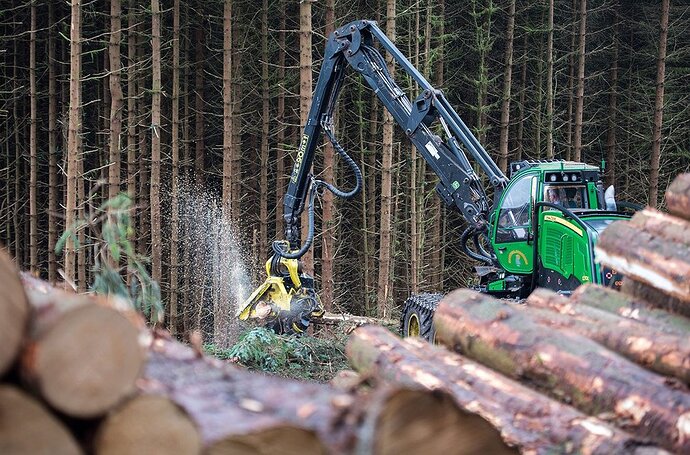Timber buildings will be instrumental in the global response to climate breakdown, locking in carbon from the atmosphere and replacing high-impact materials like concrete and steel. But increasing reliance on sawn and engineered wood over the coming decades is also expected to put huge pressure on sustainable commercial forestry, a. And with fierce competition for wood biomass from other industries, such as aviation and power, there are concerns that supply may be outstripped by demand, putting net-zero targets in jeopardy.
A report published last year by sustainability consultancy Metabolic forecast that, to meet a target for 50 per cent bio-based residential construction in Europe in 2030 (corresponding to an 18 per cent drop in carbon emissions), production of engineered timber would need to increase nearly fivefold and roundwood by four and a half times. The study concludes that the increase in wood consumption is not compatible with the realistic growth potential of harvesting, making it necessary for decision-makers to carefully weigh up their options.
The World Bank has forecast that global demand for timber could quadruple by 2050, driven mainly by population growth and associated changes in consumption as economies seek to decarbonise. Construction will be a major source of that demand. Recent joint analysis by Defra and the timber industry found that if the proportion of low-rise homes built with timber frames in the UK increased from around 20 per cent today to 80 per cent by 2050 it would require a 14 per cent increase of sawn wood supply.
David Hopkins, chief executive at trade body Timber Development UK tells RIBAJ: ‘If this government makes good on its housing promises and increases building in timber, which is the plan, it would put pressure on resources. And if every country in Europe did the same thing, that would put a lot of pressure on resource, it wouldn’t take much for demand to outstrip supply.’
With no structural internal partition walls and services carefully co-ordinated to minimise visual intrusion, the Black and White Building’s layout can be adapted as demands change. Credit: Ed Reeve
France already requires all new public buildings to contain at least 50 per cent wood and, from 2025, 20 per cent of new homes in Amsterdam must be built of timber or bio-based materials. In the US, the use of mass timber has been doubling year on year. In the run-up to 2050, construction will also have to fight for its share of timber with other industries. Half of all European-sourced wood is burnt for energy, either directly in power stations or stoves, or as an indirect ‘waste’ stream from sawmills and other industries.
The use of wood pulp to create paper and card is forecast to ramp up as population growth drives demand for more packaging. In addition, the move towards a bio-based economy – using biotechnology and biomass as an alternative to fossil fuels in the production of products and power – is expected to play a major role in international efforts to cut emissions.
‘Theoretically, everything currently oil-based could be flipped to wood-based,’ says Paul Brannen, a former MEP and author of the book Timber! How Wood Can Help Save the World from Climate Breakdown. He adds that two major trends on the horizon are using wood fibre to manufacture biofuels for aviation and shipping, and using it to make textiles. ‘The number one feedstock for making low carbon aviation fuel, before agricultural waste or agricultural residue, is Sitka wood, which is also the number one construction material in the UK,’ he says.
1 of 2
Increasing efforts are being made to achieve sustainable timber harvesting in UK forests. Credit: BSW Timber
1 of 2
The vital role of timber across numerous applications is making it an increasingly valuable and sought-after resource. Credit: BSW Timber
Limited resource
Simply chopping down more trees to meet rising demand is not a viable solution due to the limited amount of land devoted to commercial tree farming. Forestry is deemed sustainable when countries do not exceed their allotted net annual increment, defined as the volume of trees felled, minus natural losses due to death and disease.
In Europe, the logging industry removed an estimated 65 per cent of the net annual increment in 2021, according to the latest figures from Eurostat. Germany was close to maxing out its quota, at 99 per cent, and the Czech Republic exceeded it, at 104 per cent. Reaching 100 per cent can be complicated because many parts of the forest are inaccessible, and large areas are preserved for nature – the EU Biodiversity Strategy for 2030 targets a maximum of 30 per cent of forest available for commercial logging.
Matters are further complicated by geopolitical issues and the impact of climate change. Russia used to supply 10 per cent of all softwood in Europe, but is now out of bounds due to the war in Ukraine. Forest fires in Canada have wiped out previously productive areas and this is likely to become more frequent as the climate heats up. Warmer temperatures also allow pests to thrive, for example, the spruce bark beetle is making its way further north, damaging trees and taking timber out of production.
And even if there were enough trees to farm, sawmills in Europe and the US have reduced their capacity due to current flat demand as the market struggles post-Coivid economic impacts and the increased prices of materials, including timber. The potential result could be a lag between increasing demand and the sector’s ability to produce.
1 of 2
The hybrid structure of the Black and White Building comprises a beech LVL frame with CLT slabs and core, and has been designed to create vast open workspaces. Credit: The Office Group
1 of 2
The timber louvres change in depth as they rise up the facade, protecting the building from solar gain. Credit: Ed Reeve
The lumber dilemma is rising up the political agenda, with many governments under pressure to act to increase forest cover and sustainable tree planting. In 2023, the Conservative government drew up a UK Timber in Construction Roadmap, and this has been taken on by Labour. This commits to exploring ways to more productively plant softwoods and hardwoods in England to meet increasing demands from construction. Among other things, it pledges a review of regulatory processes for woodland creation and to identify opportunities to streamline application times for new forestry proposals.
According to Brannen, opportunities to promote agroforestry – planting strips of trees alongside crops or animals on farms – may be particularly effective, with evidence suggesting that up to 10 per cent of farmland can be planted without reducing cereal or meat production. ‘For farmers, it diversifies their income stream and spreads the risk,’ he says.
The UK roadmap also underlines the need for the greater uptake of homegrown softwoods, in particular those with the strength class C16, which can meet the demands of many buildings, but are often not specified due to the industry’s familiarity with higher grade C24 timber imported from Europe.
‘Timber Development UK has published span tables and technical publications showing that, for most structural uses for most family home types in the UK, you can use homegrown timber for pretty much everything,’ says Hopkins. ‘There’s a bit of snobbery about homegrown versus Scandinavian timber. We’ve got to get over that.’
That sentiment is shared by Simon Sturgis, architect and founder of carbon consultancy Targeting Zero, ‘One of the benefits of the UK having our own wind power and solar power is we don’t rely on other countries for fuel,’ he says. ‘You could argue the same thing should apply to construction materials. The more that we can home grow, the less we have to import and the less reliant we are on other parts of the world.’
The Black and White Building’s precision-engineered components will allow it to be disassembled at the end of its life. Credit: The Office Group
Design efficiency
It’s sometimes hard to see the wood for the trees, and in the context of timber construction that could mean taking the strain off forestry and prioritising the reuse and adaptation of existing buildings and structures, minimising the need for demolition.
Architects and other consultants have a role to play in ensuring wood resources are used more efficiently and not over-engineered. Cross-laminated timber (CLT) might be appealing to the eye, but it comprises mostly sawn lumber, whereas laminated veneer lumber (LVL) makes use of new species and smaller trees not normally put into production.
‘If you want to build up to three or four storeys, and are planning on building it with CLT, the building is over-engineered,’ says Brannen. ‘LVL is structurally strong enough to do that.’ He adds that when using CLT or glulam for high rise, the upper storeys don’t need to support much weight and could be made from LVL.
We may be only in the foothills of what is possible with sustainable engineered timber. Where today’s products are built up using layers of the same type of wood, in future, multiple species and veneers could make up the sandwich.
‘The engineering of the manufacturing is becoming ever more sophisticated, as are the adhesives,’ says Andrew Waugh, founding director at Waugh Thistleton Architects. ‘The opportunities to reuse timber for CLT and various types of strand board are also exciting, and form part of the Horizon Research project Woodcircles we are involved in.’
Another exciting area of innovation is timber architecture designed for long-term adaptability and reuse, helping the material retain its value in a circular economy. Waugh Thistleton’s Black & White building (pictured) in Hackney uses bolted connections. This means that at the end of its life, it can be disassembled rather than demolished, and its materials reused.
Whatever trajectory the industry takes over the coming years, it’s clear there won’t be a shortage of exciting applications – in fact, these may well expand rapidly – for this hugely versatile, attractive and sustainable material.






